Mowing helps the lawn to stay neat, clean, and healthy, so it is necessary to do it often. Mowing the lawn at the right time and height gives a mesmerizing look to the garden and promotes grass growth at its highest peak.
Generally, an average homeowner should mow their lawn every 6-7 days to keep it in shape. However, if there is excessive rain or you fertilize your lawn heavily, you might need to mow your lawn every 4-5 days. Trimming up to 1/3 of the total length in a single mow is recommended.
In this article, we will discuss how often you should mow your lawn and what mistakes can cause while mowing. Let’s read further for more details.
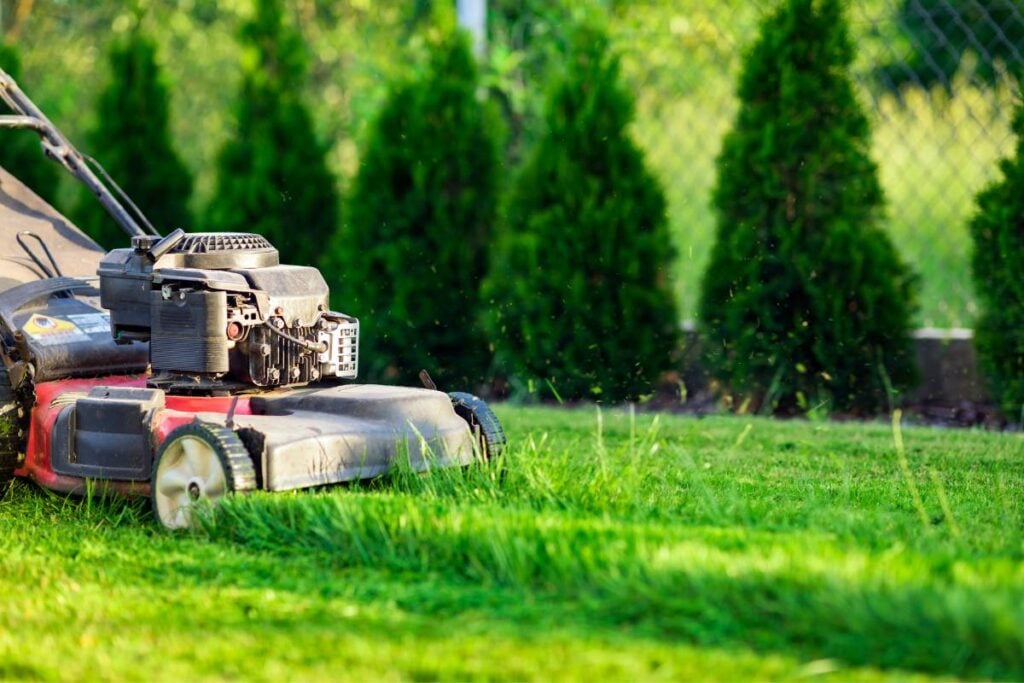
When should you mow?
It would help if you started mowing your lawn during the growing season, like spring or fall.
During the growing season, the grass shows more healthy and green growth.
You should mow your lawn once per week during the growing season, but the frequency also depends on how much it rains and how often you fertilize it.
You should avoid mowing the lawn when it’s wet as it can cause damage to the mower as well as the ground, and it can also be messy.
How often should you mow your lawn according to different seasons?
If you want to know how often you should mow your lawn, then the season plays an important role.
Now, let’s discuss how often you mow your lawn according to seasons.
How often to mow during summer?
You should mow your lawn every 4-6 days during summer days.
However, if you live in an area where it’s frequently raining, or you are often fertilizing, the lawn needs to be trimmed every 3-4 days to prevent the grass from growing too long.
On the other hand, if the weather is dry and hot, you can mow the lawn every 5 or 6 days.
But make sure you never wait an entire week to mow the lawn.
In rare cases, when the weather becomes extremely drought, and the grass stops growing completely for a while, you should wait for 10 days; otherwise, your lawn will turn brown.
How often to mow in the spring season?
During April and May, you should mow your lawn once every 2 weeks to maintain a clean, healthy, and optimum length.
If the weather stays warmer during spring and the night temperature remains above 50 degrees, you should mow the lawn every 6-7 days.
But keep in mind, if the weather starts acting like summer, you should change the mowing schedule like it’s summer season, ignoring the fact that the calendar claims.
How often to mow during fall?
During the beginning of the spring season, like in September and early October, you need to mow your lawn every 6-7 days.
But as time goes by, the temperature decreases consistently, so you need to reduce the frequency too.
Try to mow your lawn every 8-9 days and then change it to 10-14 days until you completely stop mowing before winter.
Looking for gardening supplies? We have tested 100's of products before recommending them to you guys. Check out our best pick below:
| Image | Gardening Supplies | Best Price? |
|---|---|---|
 Top
Top Top
Top | Raised Garden Bed Kit | Check On Amazon |
 | XLUX Soil Moisture Meter, Plant Water Monitor, Soil Hygrometer Sensor for Gardening, Farming, Indoor and Outdoor Plants, No Batteries Required | No Results |
 Top
Top Top
Top | 82 Pcs Garden Tools Set and Extra Succulent Tools Set | Check On Amazon |
 | Joeys Garden Expandable Garden Hose with 8 Function Hose Nozzle, Lightweight Anti-Kink Flexible Garden Hoses, Extra Strength Fabric with Double Latex Core, (50 FT, Black) | No Results |
 Top
Top Top
Top | Dual Chamber Compost Tumbler | Check On Amazon |
 Top
Top Top
Top | Sunnyglade Plant Stakes | Check On Amazon |
 Top
Top Top
Top | Organic Cold Pressed Neem Seed Oil | Check On Amazon |
 Top
Top Top
Top | Mighty Mint Gallon :-Insect and Pest Control Peppermint Oil | Check On Amazon |
 Top
Top Top
Top | Scotts DiseaseEx Lawn Fungicide | Check On Amazon |
 Top
Top Top
Top | Jacks Classic 20-20-20 All Purpose Fertilizer | Check On Amazon |
 Top
Top Top
Top | 30,000 Seeds Pollinator Attracting Wildflower Mixture | Check On Amazon |
 Top
Top Top
Top | Survival Vegetable Seeds Garden Kit-Over 16,000 Seeds | Check On Amazon |
How often to mow during winter?
When winter arrives, you should avoid mowing the lawn completely as it’s the dormant period.
But even if you want to maintain the length of your grass, you can trim it every 5-6 weeks.
But not frequently.
However, be careful while trimming the grass as the wetness in the ground can easily damage the grass.
How often should you mow based on grass type?
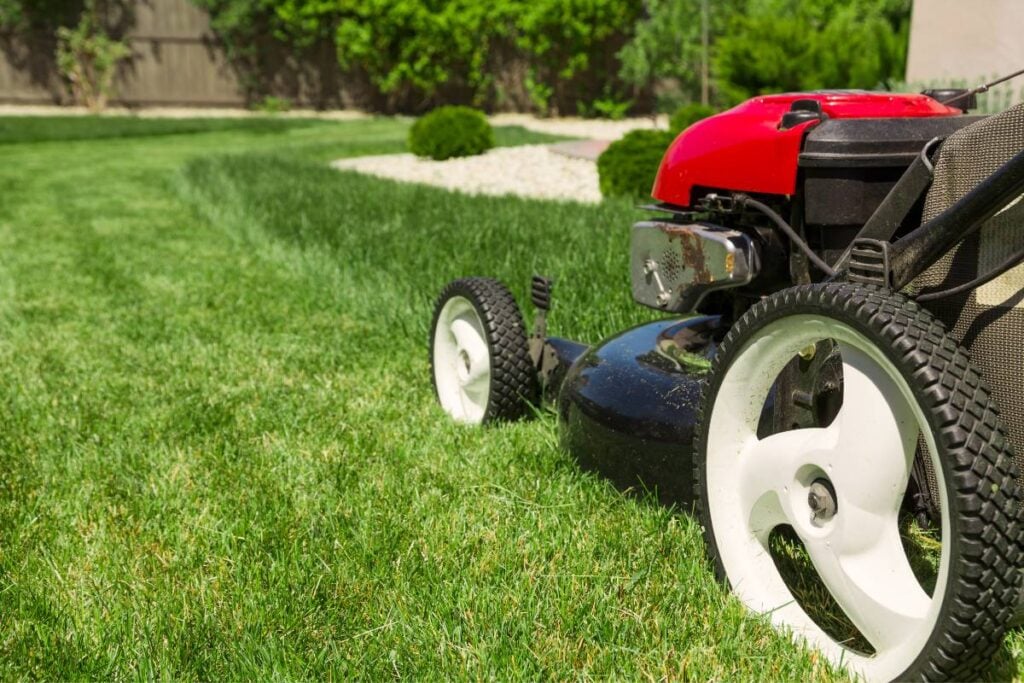
Grass type also plays an important factor in how often you should mow your lawn.
Some grass prefers to be cut higher, while others prefer to stay a few inches closer to the soil.
Knowing the grass type and maintaining its best height for a neat and well-maintained lawn is important.
Let us discuss each grass type in detail:-
Cool season grass
Cool-season grasses grow efficiently during spring and fall. Bluegrass, fescues, and ryegrasses are one of them.
These grasses need to be trimmed more frequently during rainfall.
That means the more it rains, the more frequently the grasses need to be cut.
Mowing the cool season grasses frequently in spring months also helps to prevent the growth of unwanted plants like broadleaf weeds.
But as soon as the summer season arrives, you should reduce the mowing frequency as the growth of cool-season grasses gets slow.
Warm season grass
Warm-season grasses are generally found in southwestern and southern states where summers are hot and mild winters.
Grasses like Bermuda, Zoysia, Buffalo, and St. Augustine grow best in warmer conditions and generally slow their growth during winters.
So, they must be mowed more frequently during the summer, like every 6-7 days.
Just like cool-season grasses, warm-season grasses also need to be mowed more frequently during heavy rainfall.
New grass
You should avoid mowing new grasses in the lawn until and unless it grows actively.
Mowing the sensitive new grasses can damage the new leaves, and they can even stop growing because of disturbance.
Once the new grasses have achieved optimum height, you can start mowing them.
Recommended heights for grasses in lawns
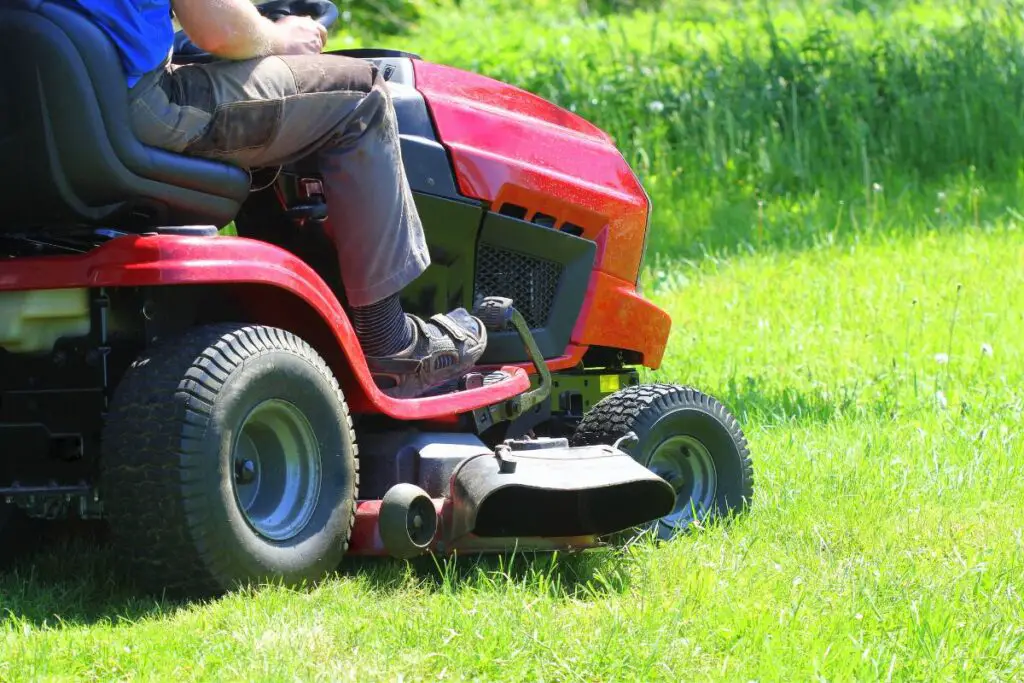
After knowing how often you should mow your lawn grasses, it is also important to know their recommended cutting heights.
Let us discuss different cutting heights for each grass type.
Optimal mowing height for different grasses
| Grass name | Recommended Grass height | Grass type |
|---|---|---|
| Kentucky bluegrass(Poa pratensis) | 2.5 to 3.5 inches | Cool season grass |
| Perennial ryegrass(Lolium perenne) | 1.5 to 2.5 inches | Cool season grass |
| Tall fescue( Festuca arundinacea) | 2 to 3 inches | Cool season grass |
| Creeping red fescue(Festuca Rubra) | 3 to 3.5 inches | Cool season grass |
| Hybrid Bermuda | 1 to 1.5 inches | Warm season grass |
| Common Bermuda grass | 1 to 2 inches | Warm season grass |
| Buffalo turf( St. Augustine) | 2 to 3 inches | Warm season grass |
| Centipede(Eremochloa ophiuroides) | 1 to 2 inches | Warm season grass |
| Zoysia | 1 to 2 inches | Warm season grass |
According to different grass types and growth rates, you can determine how often and how much they need to be mowed.
If the grass has a good growth rate, it must be mowed more often than other grass types.
So, try to find out what type of grass you have on your lawn and then mow it accordingly.
The best time to mow your lawn
Let’s discuss what time is best and worst to mow your lawn.
Early morning
Mowing the grass early in the morning is the worst time.
During the morning, the grass stays wet because of the morning dew.
Morning dew is the water droplet that forms on the leaves early in the morning due to water vapor.
The wet grass makes it difficult for the mower to cut, and it can tear the grass poorly.
Also, wet grass can easily invite fungi and diseases.
Mid-morning
Mid-morning is one of the optimum times to mow your lawn because the grass gets enough time to dry out the dew, and the heat doesn’t get harsh.
When you mow the lawn mid-morning, the grass will have enough time to recover from cutting before getting hit by the scorching heat.
So, if you are still trying to choose the best time, then you can mow during mid-morning.
Midday
Mowing during midday is also unsuitable for the lawn as it is the hottest part of the day.
Cutting the grass during this time can stress them.
If you mow less than the top third of the grass, it can hardly cause any harm.
But if you are planning to cut more than the top third, then you can put the lawn at risk because of burning.
Afternoon
Another best time to mow your lawn is during the afternoon.
If it’s hard for you to mown during mid-morning and you don’t want to risk your lawn from the scorching heat, then the afternoon is one of the best times to cut your grasses off.
Evening
Mowing the lawn in the evening is not a good idea as the temperature decreases, the grass gets moist, and the dew settles in.
Cuts in the evening can easily infect grasses with fungal infections and diseases.
1/3rd rule while mowing
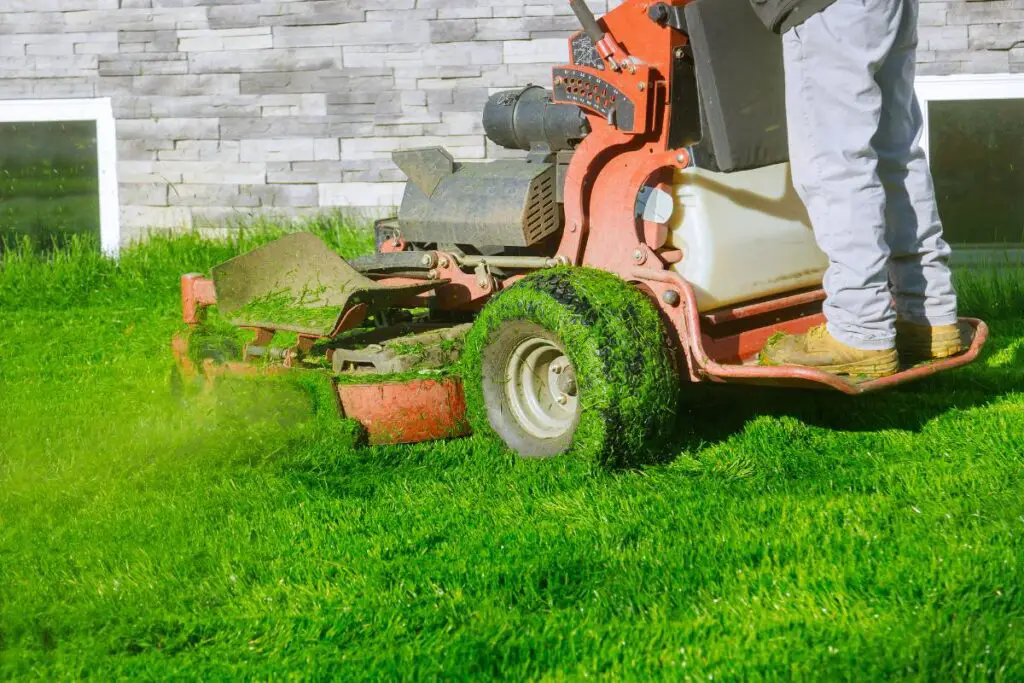
Make sure, while mowing, you should always follow a one-third rule.
You should never suddenly cut more than 1/3rd of the grass blade length in one go.
Removing more than 1/3 can stress the grass as it can harm the stems and even die.
To find out whether you have stressed the grasses or not, you will get to see the grasses fading away and turning brown and yellow.
To avoid stressing the grasses, lift your mower height to prevent cutting more than 1/3rd of the grasses.
If you want to maintain a particular grass size in your lawn, remove the grass frequently, little by little, i.e., one-half of the leaves, until you get the perfect grass height.
Never cut the grass too closely.
If the grass has grown extremely tall, i.e., 5 inches, and you want them back to its normal height, for example, 2 inches. Then don’t cut the 3 inches in one go.
First, remove the first 2 inches of your grass. Now, the grasses are 3 inches. Then wait for a few days until the grass grows one more inch.
Then cut that 1 inch of grass.
It is how you will be able to maintain proper height.
Common mowing mistakes
There are a few mistakes that people make while mowing their lawns. Let’s discuss the mistakes that should be avoided strictly.
- Blunt blades- Using blunt blades can tear the grasses improperly, damaging the stems and tissues and leaving the grasses completely weak. It can invite various diseases, and the entire lawn can slowly turn brown.
- Scalping- Scalping happens when the mower height is adjusted lower than the preferred height of cut for the grass. Due to this mistake, the grasses are mowed off very low, exposing the stems and crown. Unwanted scalping can also happen due to uneven ground or bumps.
- Cutting wet grass- Mowing the wet grasses can leave ruts in your lawn, and it can also leave large clusters of clippings that could suffocate the grass. It could be a big mess to clean and bring back the ground to its normal form.
- Mowing in the same direction- If the grasses are continuously mowed in the same direction, it results in permanent tire rutting, damaging the entire lawn.
Mowing tips
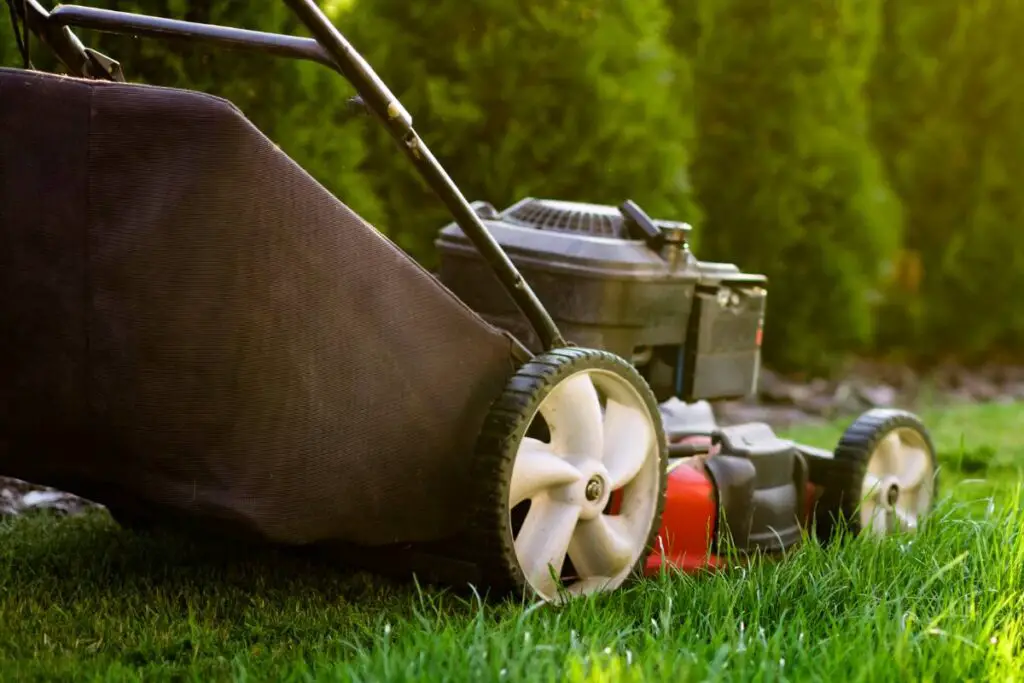
- Always mow when the grass is completely dry to avoid mess.
- Don’t mow your lawn during extreme heat to avoid stressing the grasses.
- The best time to mow your lawn is between 8 am to 10 am.
- Use sharp blades to maintain a proper and clean cut. Otherwise, the chances of pests and diseases become higher.
- Always try to mow in different directions to avoid any ruts.
- Throw the leftover clippings from the areas which are already trimmed.
- Try to use a mulching kit on your mower for a nitrogen boost.
- Raise the mowing height to avoid cutting the grass too much.
- Decrease the mowing frequency according to season and grass type, i.e., reduce mowing for cool-season grass during summer and warm-season grass during winter.
- Fertilize the grass with a lawn fertilizer frequently to encourage healthy growth.
Final words
It is important to make a clean cut at the right time to maintain your lawn.
If you want to know how often you should mow your lawn, it is important to know the season and grass type.
Once you know both, you can easily maintain the correct frequency of mowing your lawn.
You should also be careful while mowing the lawn and avoid common mistakes like using blunt blades, cutting too short, mowing wet grass, etc.
Reference: Lawn Mower Technology, Lawn Mower Safety, Lawn Mowing, Lawn Care, Mowing your lawn.
